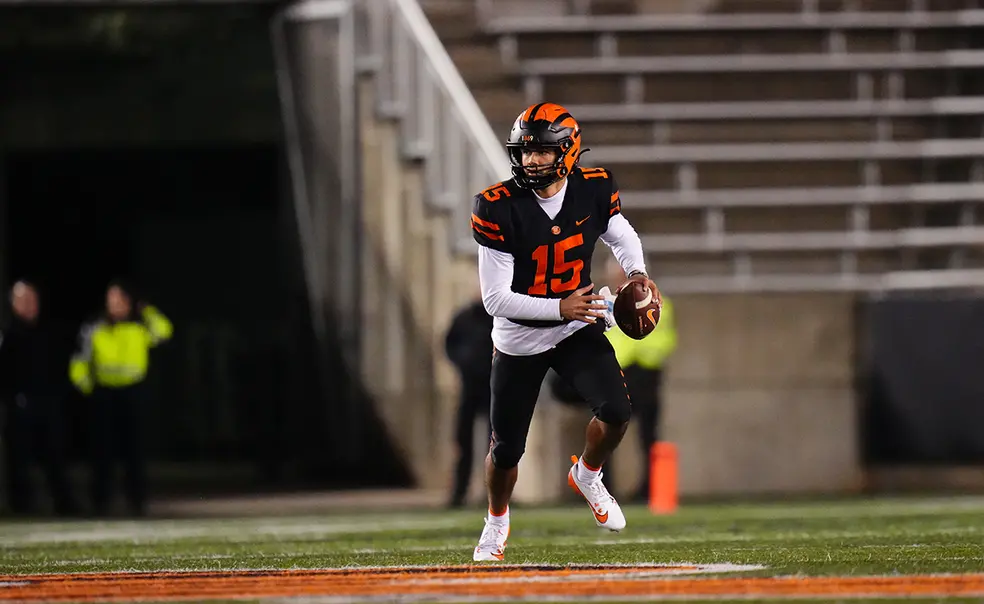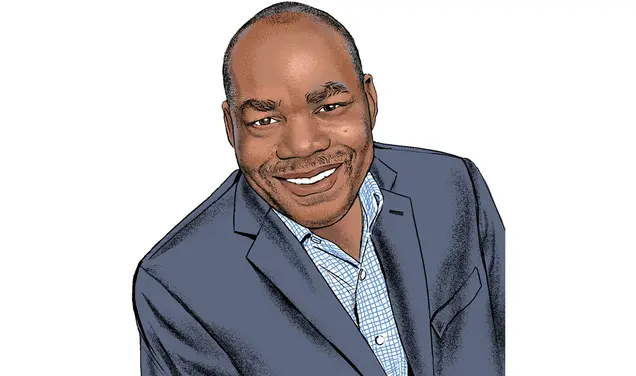Football Preview: Princeton Looks to Bounce Back in 2025
Experienced defense, returning quarterback could be among the Tigers’ strengths this fall
The 2024 season was a rare disappointment in the recent history of Princeton football. The Tigers finished 3-7 — their first losing campaign since 2011 — and the normally dynamic offense sputtered, ranking last in the Ivy League with 276.5 yards per game, nearly 100 yards behind seventh-ranked Penn.
But in August, with the standings reset, head coach Bob Surace ’90 found reasons for optimism in 2025. Stressing fitness in the offseason led to the team’s best results in the conditioning test that players complete at the opening of training camp. And the defense, decimated by injuries last year, now seems like a potential strength, with 13 returning players who have spent at least one week in the starting lineup.
Running back Ethan Clark ’27 is healthy after an illness interrupted his breakout sophomore season. Quarterback Blaine Hipa ’26 appears to have the inside track to return to his starting role, though Surace said no positions were set as of late August. The coach complimented the offense’s performance in spring practices. “I thought we really executed, overall, as an offense,” he said. “In the pass game, you can see the timing, and all the decision-making has been spot on.”
Hipa, a promising left-hander from Hawaii, had a 2-7 record in nine starts as a junior. He threw for 10 touchdowns, ran for three, and was intercepted 15 times. The second half of his season showed significant improvement in completion percentage (50.4% in the first five games, 60.2% in the last four) and passing yards (167.4 in the first five games, 207 in the last four). “I think my confidence went up a little bit more,” Hipa told PAW. “I tried to trust myself more.”
Hipa’s offseason priorities included improving his pocket presence and footwork. He worked with private quarterbacks coach Tony Racioppi, whose past pupils include NFL players Kenny Pickett and Tommy DeVito. He’s also tried to learn from those nine games in 2024. “I watched a lot of film from last year, just to kind of see areas I can improve in, obviously, and also to see things I did well,” he said.
The receiving corps will be adding some new targets after the graduation of Princeton’s top three wideouts, Luke Colella ’25, A.J. Barber ’25, and Matthew Mahoney ’25. Jalen Geer ’26, who caught 13 passes for 159 yards last season, is the leading returner. Fellow senior Charley Rossi had limited opportunities last year as Barber’s backup, but he caught two touchdown passes in Princeton’s loss to Cornell.
After leading summer workouts on campus, Hipa was excited to see the offense coming together. “All we’re looking to do this season is compete — be the best version of ourselves all year,” he said. “I think we’re ready to do that.”
When describing the difficult choices Princeton’s defense had to make last year, Surace pointed to week eight — the leadup to the Dartmouth game — and linebacker Marco Scarano ’26. Scarano had been brilliant as a strong-side outside linebacker, but injuries at middle linebacker opened an urgent need.
“After practice, we were like, ‘We’ve got to move Marco,’” Surace said. “‘It’s either Marco [or] we’re going to have to play really young guys.’ And he learned the defense that night.” After one day of practice, Scarano took the field against Dartmouth and made a team-high 16 tackles (four solo, 12 assisted).
In a season filled with injuries, though, not every substitution went so well for the Tigers. For the year, the defense ranked a respectable second among Ivy teams in passing yards allowed, but that was partly because their opponents had the fewest pass attempts. Princeton also surrendered a league-worst 24 rushing touchdowns.
The silver lining of in-game experience has Surace expecting improvement this year. “Right now, they’re ahead of where we were last year,” he said. “There’s probably 20 guys on the defense that have played at least half the snaps in a game.”
Safety Nasir Hill ’26 said the Tigers are aiming to field a fast, physical defense that doesn’t back down from the prolific offenses around the Ivy League.
“It’s the standard for us: Don’t flinch,” he said. “Any situation, any circumstance, [we’re] trying to make sure that we’re prepared for it, so there’s no need, you know, to fold, get nervous, anything like that.”
The 2025 season will be the first in which the Ivy League football champion will earn an automatic bid to the Football Championship Subdivision (FCS) playoffs — and the first time that an Ivy football team will play in the postseason since Columbia’s win over Stanford in the 1934 Rose Bowl.
Surace made no secret that he was in favor of sending teams to the playoffs, joking that he spent time in “three different [athletic directors’] offices getting my wrist slapped for saying a little too much.” For decades, Ivy champions in other sports have had the opportunity to test themselves against top teams from around the country, and now football will join that tradition.
“I think competitors want to compete, and everywhere else I’ve coached you had the ability to do that,” Surace said. “You get to know where you stand.”
In a preseason media call, Robin Harris, the league’s executive director, credited a “dedicated and thoughtful” student advisory committee for leading the charge to lift the postseason ban. She also noted that from 2019 through 2024, Ivy football teams had a winning percentage of more than .700 in nonconference games, which could factor into at-large selections for the 24-team FCS postseason field.
“We’re ready, and we fully believe that like in many other sports, we will have multiple teams in the playoff conversation,” Harris said.
Princeton’s nonconference slate features Mercer (home on Oct. 11), a 2024 FCS quarterfinalist that ranks 11th in the national preseason coaches’ poll, and two other teams that were .500 or better last season, San Diego (home on Sept. 20) and Lafayette (away on Sept. 27).












No responses yet